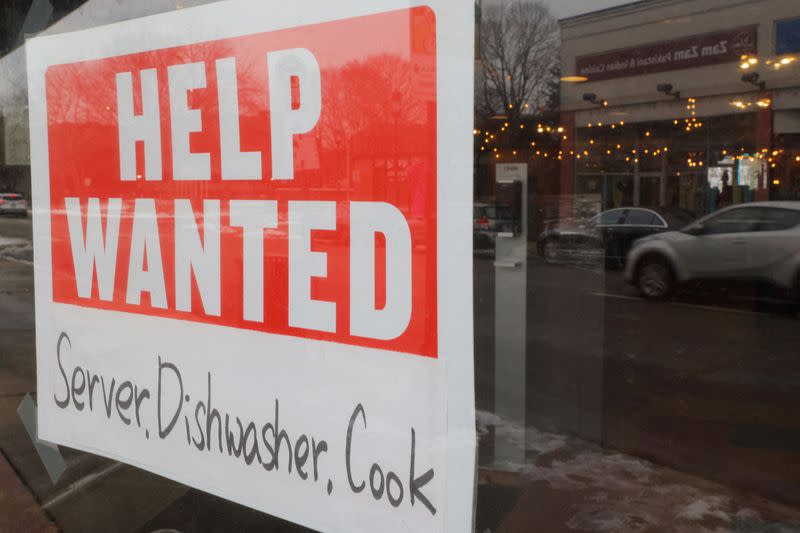US job gains surge past expectations, wage growth quickens

By Lindsay Dunsmuir
(Reuters) -The U.S. economy created far more jobs than expected in May and annual wage growth reaccelerated, underscoring the resilience of the labor market and reducing the likelihood the Federal Reserve will be able to start rate cuts in September.
The Labor Department's closely watched employment report on Friday also showed the unemployment rate ticked up to 4.0% from 3.9% in April, a symbolic threshold below which the jobless rate had previously held for 27 straight months.
The unexpectedly strong report made plain that while the labor market has softened around the edges in recent months, its still-solid performance is set to underpin economic growth and keep the Fed on the sidelines and taking its time in deciding when to begin lowering borrowing costs. The hotter-than-expected wage gains also raised the prospect that elevated inflation may prove stickier than hoped although the impact from the rise in the unemployment rate could temper that.
Financial markets slashed the odds of a September rate cut, reducing the probability to about 53% from about 70% before the report, based on rate futures contracts, and now see roughly an even chance of two rate cuts by the end of 2024, versus about a 68% chance seen before the report.
"So much for slowing. The headline payrolls number is eye popping.... The Fed will take this to mean that they can still focus squarely on inflation without worrying much about growth," said Brian Jacobsen, chief economist at Annex Wealth Management.
The yield on the 2-year Treasury note, which is sensitive to Fed policy expectations, shot up by the most in two months. Yields across other maturities rose sharply as well. The report put stocks on the defensive after a rally led by the AI sector that had carried major indexes to record highs this week. The dollar strengthened broadly.
Nonfarm payrolls increased by 272,000 jobs last month, the Labor Department's Bureau of Labor Statistics said. Revisions showed 15,000 fewer jobs created in March and April combined than previously reported. Economists polled by Reuters had forecast payrolls advancing by 185,000. Estimates ranged from 120,000 to 258,000. May's employment gains were higher than the 232,000 monthly average for the past year.
CONFLICTING SIGNALS
Hiring was widespread across the economy, with a measure of its diversity at its highest level since January last year. The healthcare sector added 68,000 jobs, spread across ambulatory healthcare services, hospitals, nursing and residential care facilities. It continued to lead employment gains as companies seek to boost staffing levels after losing workers during the pandemic.
Government payrolls increased by 43,000 positions. Employment in the leisure and hospitality sector rose by 42,000 jobs, with slightly more than half that total coming from employment in food services and drinking places.
Professional and business services hired 32,000 more workers, driven by management, scientific and technical consulting services and architectural and engineering-related services. Social assistance and retail hiring also trended up last month. There were small job losses at department stores and home furnishings retailers.
The U.S. central bank is expected to leave its benchmark overnight interest rate unchanged at its meeting next week in the current 5.25%-5.50% range, where it has been since last July.
Average hourly earnings rose 0.4% after having slowed to a 0.2% rate in April. Wages increased 4.1% in the 12 months through May following an upwardly revised 4.0% annual rise the prior month. Wage growth in a 3.0%-3.5% range is seen as consistent with the Fed's 2% inflation target. The average workweek was unchanged at 34.3 hours.
"Accelerating pay growth could be a sign of inflationary pressures ready to rebound if the Fed takes their foot off the brake. On the other hand, higher unemployment could signal weaker wage growth ahead, softer consumer demand, and less pricing power for businesses, which would cool inflation," said Bill Adams, chief economist at Comerica Bank.
The U.S. central bank is closely monitoring labor market conditions and economic growth to ensure it doesn't keep rates too high for too long and overcool the economy as it tries to return inflation back to its 2% target. At 4.0%, the jobless rate in May was at the level the Fed in March predicted it would reach by the end of this year.
Overall economic output in the first quarter grew at the slowest rate in nearly two years and other data so far in the current quarter, aside from monthly payrolls growth and inflation, on balance has been weaker than expected.
Data earlier this week showed job openings declined in April and the number of available jobs per job-seeker reached its lowest level since June 2021.
Friday's data showed the labor force participation rate fell to 62.5% in May from 62.7% in April, reversing this year's progress and driven by fewer workers in the 20-24 age range. But participation by the prime-age population, defined as those aged between 25 and 54, rose to its highest level in 22 years.
Some economists questioned the divergence between the strong job gains and the rise in the unemployment rate. The two figures are derived from separate surveys within the report. The employment measure, contained in the Household Survey, has fallen in five of last eight months. That survey showed 250,000 individuals left the labor force altogether last month.
"The employer and household surveys should tell a similar story, but it’s too early to tell whether the recent divergence is a sign of deeper cracks appearing in the foundation of the labor economy or a temporary anomaly," said Jim Baird, chief investment officer at Plante Moran Financial Advisors.
(Reporting by Lindsay Dunsmuir; Additional reporting by Johann Cherian and Chuck Mikolajczak; Editing by Paul Simao, Chizu Nomiyama and Andrea Ricci)

 Yahoo Finance
Yahoo Finance 